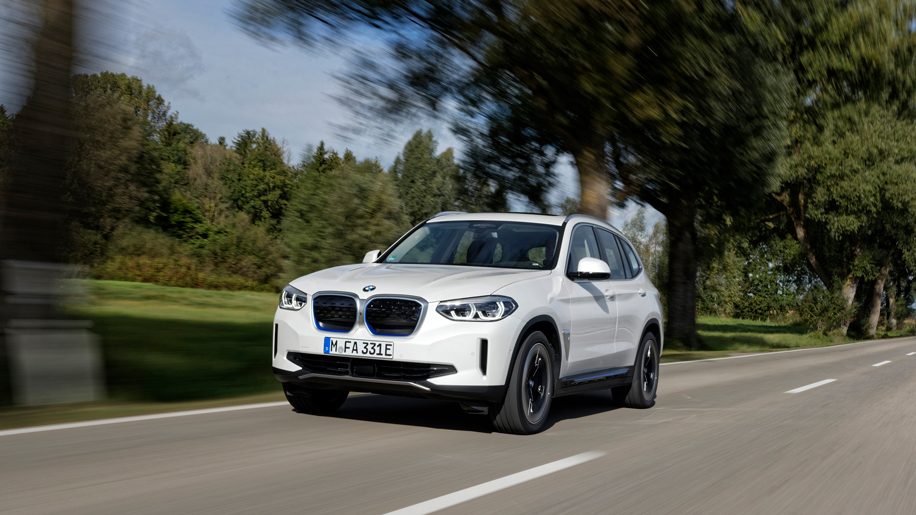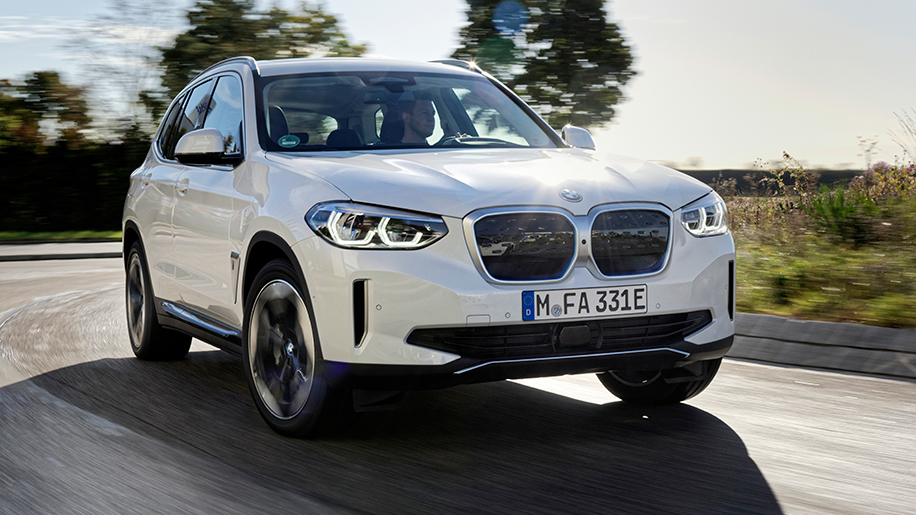
Whether you like it or not, electrification is coming to your motoring world. By 2035, the Government plans to ban the sale of all new petrol, diesel and hybrid vehicles from showrooms, so fully-electric vehicles will ultimate be the only way forward.
BMW is one car manufacturer that has been further ahead of that curve than most. Perhaps too much, in fact. The i3 hatchback and i8 supercar have been popular (sales of the i3 in particular continue to grow despite being on sale since 2013), but you could argue they were ahead of their time as hybrids and electric car sales are only now starting to gain traction.
This new all-electric iX3 SUV is the start of the next generation for BMW. And, with the i4 and iNext also arriving in showrooms in 2021, the Bavarian firm is about to strengthen its position in the EV market still further.

Blink and you’ll miss the differences between this new iX3 and the conventionally-engined X3 SUV. A ‘filled-in’ front grille with electric blue highlighting that is repeated in the surround to the external BMW badges, on the side sills and on the under-bumper trim and that’s pretty much it, apart from the chrome ‘i’ badge just behind the front wheel on the wing.
Compared to the i3 and i8 of course, the styling of the iX3 looks very traditional, but that’s BMW’s aim. This model scheme of offering multiple power/ engine choices, whether petrol, diesel or electric within the same body is one that that will continue in the future BMW range too.
With an 80kWh battery located in the iX3’s floor, it has the equivalent of 289bhp going to the rear wheels (there’s no four-wheel drive iX3) giving it a 285 mile range when fully. Performance is good with a 0 to 60mph time of 6.8 seconds and a 112mph top speed.

Will that lack of four-wheel drive deter some buyers? Aside from the entry-level petrol 20i, all other models in the X3 range have four-wheel drive (including the plug-in hybrid), so it’s ironic that this iX3 doesn’t have it, despite a price tag starting at close to £60,000. BMW claims it didn’t want to add the extra weight to do so, which is fair enough given that the iX3 already tips the scales at 2260kg.
The biggest surprise of the iX3 however is its excellent packaging, especially when it comes to boot space. While the rest of the interior is largely unchanged from the normal X3, the iX3’s boot is 510 litres with the rear seats up and 1560 litres with them folded down which is only 40 litres less than the standard car.
On the road, you’re never not aware of the extra weight of the iX3, but it’s not as detrimental as you might imagine. The steering is sharp and there’s minimal body roll inspiring plenty of confidence on twisty roads. We wouldn’t mind the driver’s seat going slightly lower though as it still feels marginally too high.

Some more feel through the steering wheel wouldn’t go amiss, but this is unlikely to be a car that many owners are going to be driving with the enthusiasm of a hot hatch. That said, it can be hustled through corners with a good degree of speed and handles surprisingly well. In Comfort mode the ride quality is good too.
Where the iX3 is really clever though is with its regenerative braking system. Like a dynamo on an old-fashioned bike, most electric cars allow you to convert the energy when braking into recharging the car’s batteries. The BMW iX3 is no different with three different levels – low, medium and high. Unusually though, there is also an adaptive mode where the iX3 decides for the driver which level of braking to use depending on the road and traffic conditions using Artificial Intelligence, the sat nav and the forward radar.
This adaptive mode works very efficiently either braking the car heavily or coasting when the road ahead is clear. BMW claims that it means 90 per cent of ‘reducing speed situations’ can be handled without using the brake pedal and in reality it works surprisingly well.

While that 285 mile range is impressive, recharging rates are never far from the minds of most EV drivers. While the iX3 comes with a Type 2 cable and three-pin household cable as standard, on a 150kW rapid charger, BMW claims a 0 to 80 per cent charge in 34 minutes. Probably more realistic is the fully-charged time of 7.5 hours on a domestic wallbox.
BMW will also offer a standard wallbox for home charging or a Smart wallbox for company car drivers, enabling them to be reimbursed for any domestic electricity that has been used for corporate use – a clever addition for any business drivers.
There’s just two versions of the iX3 on offer, the Premier Edition and Premier Edition Pro, with £3000 between them. BMW is expecting the entry-level car to be the best seller with an electric tailgate, 20in alloy wheels, adaptive suspension and a panoramic sunroof all as standard.
It would be very easy to dismiss the iX3 as an expensive step up from its plug-in hybrid alternative. But we applaud that BMW is offering another electrified choice to X3 customers and that 285 mile range makes it pretty usable as an everyday car – especially for business drivers who can take advantage of its low Benefit-in-Kind company car rates.
It’s no mistake that BMW is expecting a hefty rise in corporate sales for this iX3. It may not come cheap, but we think the iX3 is a very impressive car and could easily be one of biggest plug-in hits of 2021.
Fact file
Model: BMW iX3
On sale: summer 2021
Price: from £58,850
Engine: Electric – 80kW
Range: 285 miles
CO2 emissions: 0g/km
Nat Barnes












